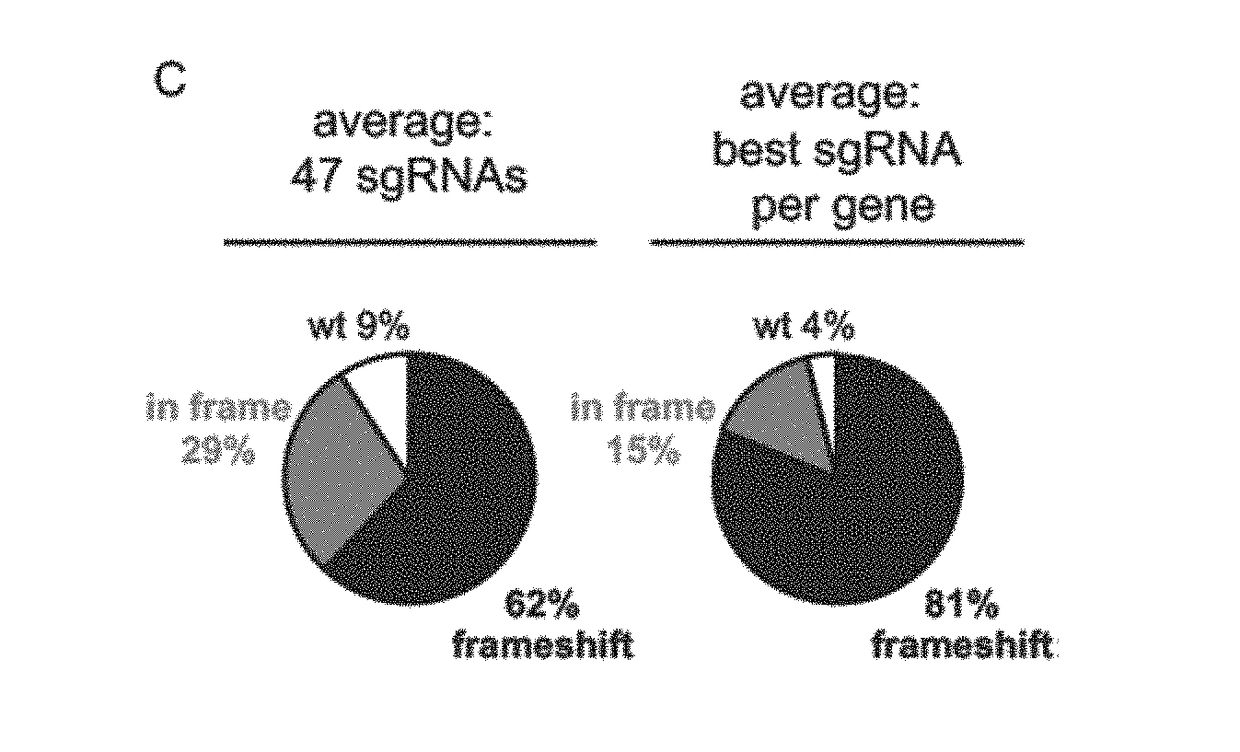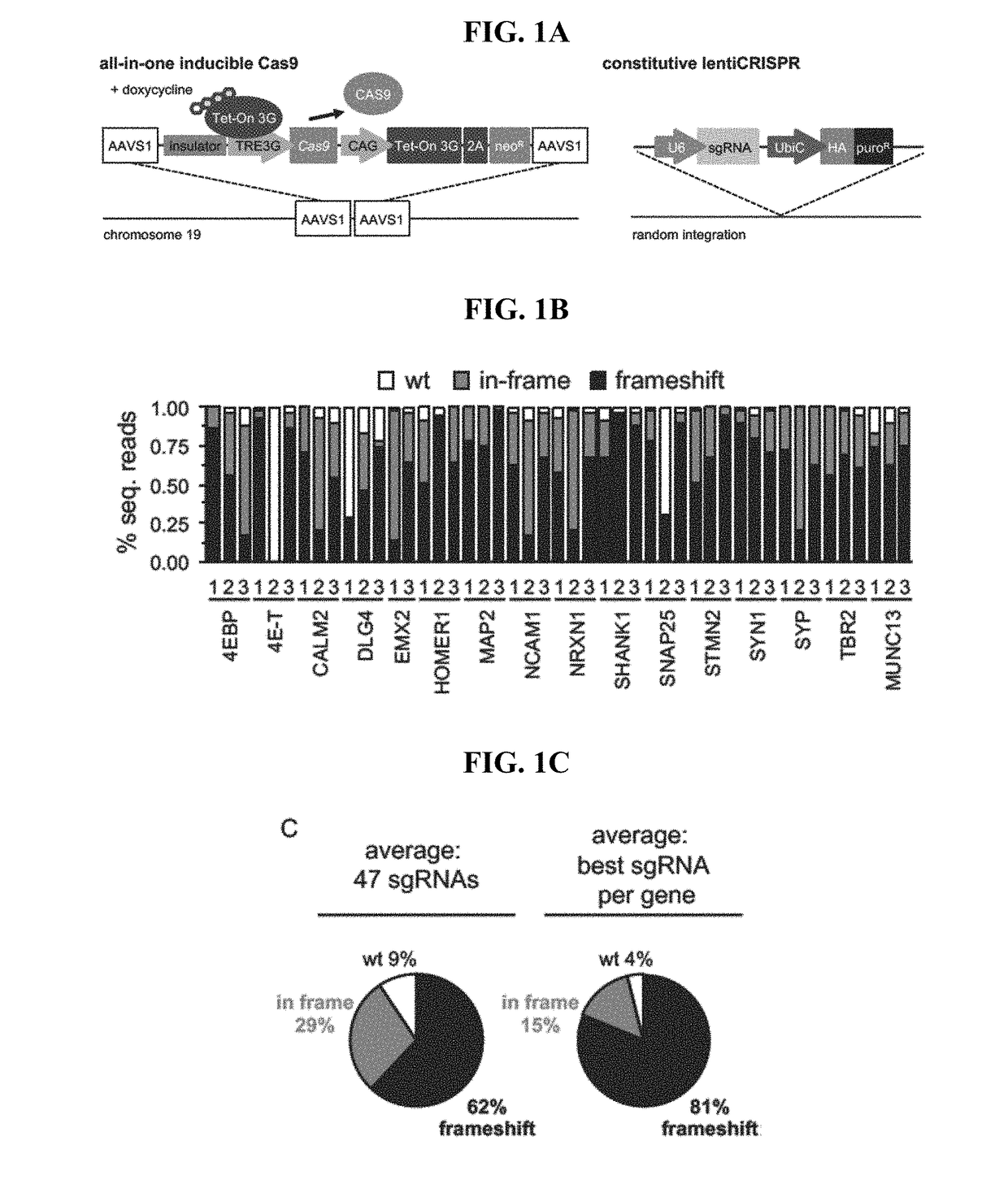Methods and compositions for enhancing gene editing
a gene editing and composition technology, applied in the field of methods and compositions for enhancing gene editing, can solve problems such as concerns about off-target toxicity of technology, and achieve the effects of reducing toxicity of gene editing system, and increasing the efficiency of homology dependent repair
- Summary
- Abstract
- Description
- Claims
- Application Information
AI Technical Summary
Benefits of technology
Problems solved by technology
Method used
Image
Examples
example 1
and Methods
[0304]hPSC Culture and Inducible Cas9 Cell Line Generation
[0305]Cells were grown in TeSR-E8 media (STEMCELL TECH.-05940) on tissue-culture plates coated with vitronectin (Gibco-A14700). Passaging was preformed using ReLeSR (STEMCELL TECH.-05873) or accutase (Gibco-A1110501) in media with thiazovivin (Selleckchem-S1459, 0.2 uM to 0.8 uM). Cell lines generated, screened and QC'd as described by Wells et al., 2016 (under review). iCas9 and ddCas9 cell lines were maintained in media containing 200 ug / ml G418 (Millipore-345812).
Lentiviral and Lipid Delivery of sgRNAs for Cas9 Mutagenesis
[0306]During replating lentiCRISPRs were added to a single cell suspension of 2*105 cells in E8 with thiazovivin without polybrene. After 24 hours cells were maintained in 2 ug / ml to puromycin. At the onset of each mutagenesis experiment Shield1 (Clontech-631037) at 0.5 uM and dox (Clontech-631311) at 2 ug / ml were added to induce Cas9. To disrupt TP53, 3 TP53-targeting crRNAs each at 30 nM were...
example 2
ndent Gene Disruption is Efficient and Toxic to hPSCs
[0315]A two-component Cas9 system was developed to allow for rapid generation of mutant hPSCs. The system consists of a stable Cas9 line used with lentiviral sgRNAs (lentiCRISPR). The streamlined all-in-one doxycycline (dox) inducible Cas9 safe-harbor (AAVS1) construct, will be henceforth referred to as iCas9 The clone used for this study had a normal karyotype, strong induction of Cas9 in the presence of dox, and was property targeted (FIGS. 5A-5E). In order to test Cas9 activity, a next generation sequencing (NGS) pipeline to detect CRISPR indels was utilized to quantify control, in-frame and frameshift reads in DNA samples. iCas9 cells were infected with lentiCRISPRs targeting 47 loci in 16 genes and treated with dox for 8 days. NGS analysis of lentiCRISPR infected cells had high percentages of indels and demonstrates this is a significant improvement over existing systems in hPSCs (FIG. 1B) Gonzalez et al. (2014) Cell Stem Cel...
example 3
reens Identify hPSC-Specific Toxic Response to Cas9-Induced DSBs
[0317]hPSCs expressing a non-targeting sgRNA have a proliferative advantage over cells expressing a targeting sgRNA. We hypothesized that non-targeting controls would increase representation when simultaneously tested with thousands of targeting sgRNAs in a pooled screen. To test this, we used a pooled sgRNA library consisting of 13,000 sgRNAs. 72 sgRNAs are non-targeting and the remaining target ˜2600 genes (5 sgRNAs / gene). 2000 cells for each sgRNA were infected at 0.5 MOI to maintain 1000× representation after puro selection (FIG. 2A). The experiment was highly controlled and four different conditions infected with the sgRNA library were tested. Two conditions were grown in the absence of Cas9 (−dox) and included the parental H1 and Hi-iCas9 cells. To further validate the toxicity and high editing efficiency in hPSCs we generated a second inducible Cas9 based on the Shield1-destabilizing domain (DD) system Banaszynsk...
PUM
| Property | Measurement | Unit |
|---|---|---|
| molecular weight | aaaaa | aaaaa |
| time | aaaaa | aaaaa |
| time | aaaaa | aaaaa |
Abstract
Description
Claims
Application Information
 Login to View More
Login to View More - R&D
- Intellectual Property
- Life Sciences
- Materials
- Tech Scout
- Unparalleled Data Quality
- Higher Quality Content
- 60% Fewer Hallucinations
Browse by: Latest US Patents, China's latest patents, Technical Efficacy Thesaurus, Application Domain, Technology Topic, Popular Technical Reports.
© 2025 PatSnap. All rights reserved.Legal|Privacy policy|Modern Slavery Act Transparency Statement|Sitemap|About US| Contact US: help@patsnap.com



